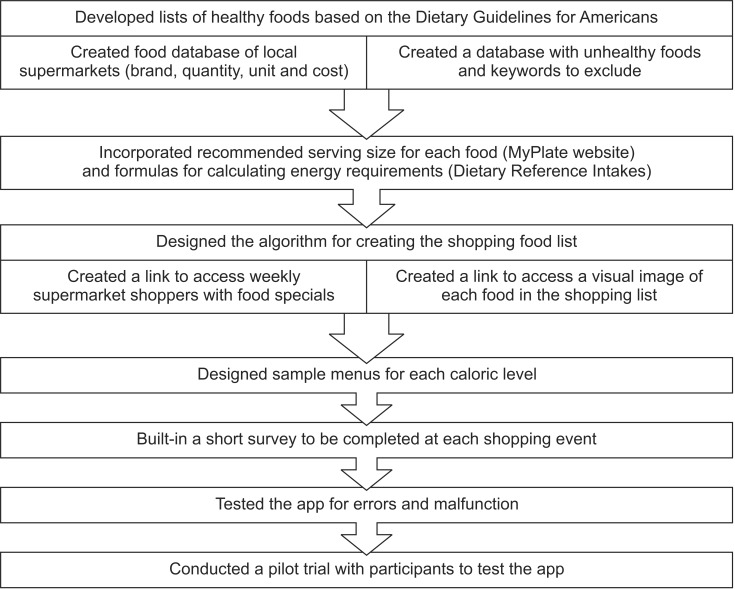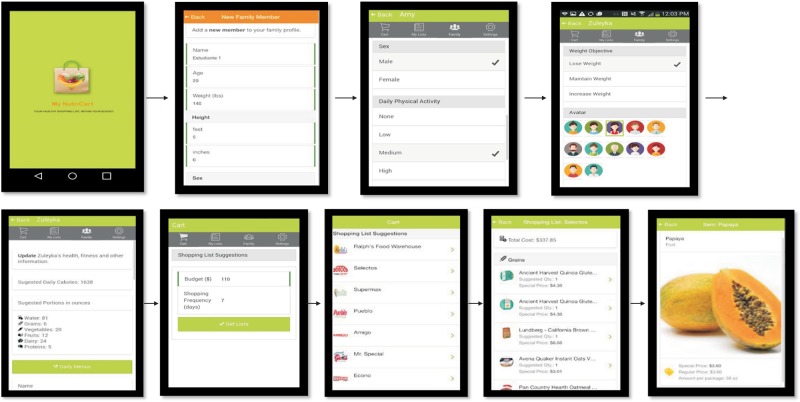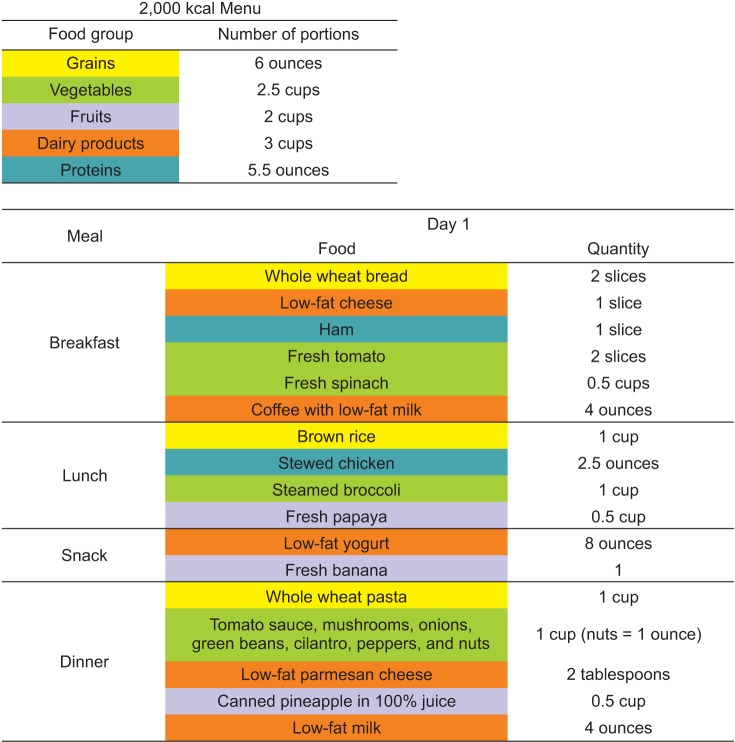Abstract
Objectives
This study developed a smartphone nutritional application (app) for making smart and healthy choices when purchasing food in grocery stores and tested its feasibility, usability, satisfaction and acceptability.
Methods
“MyNutriCart” was developed following the ADDIE (analysis, design, development, implementation, and evaluation) model. The goals of the app were to improve food selection when purchasing foods in the grocery stores based on a pre-defined budget, to improve dietary patterns based on the Dietary Guidelines for Americans, and to improve weight status. It was evaluated within a pilot randomized trial using a convenient sample of 26 overweight or obese adults aged 21–45 years for 8 weeks.
Results
The developed app provided a grocery list of healthy foods to meet the individual requirements of all family members within a budget following the recommendations of the Dietary Guidelines for Americans. The average use of the app was 75% on each purchase and only 37% of the recommended products were purchased. The main reasons for not purchasing the recommended items were that participants did not like these (28.5%) and that the item was unavailable in the supermarket (24.3%). Over 50% of participants considered the app as feasible, usable, satisfactory, and acceptable (p < 0.05).
Conclusions
“MyNutriCart” is the first available app for making smart and healthy choices when purchasing food in grocery stores. This app could be used as a tool to translate recommendations into a practical grocery list that meet the needs of a family within a budget.
Keywords: Obesity, Mobile Applications, Diet, Educational Technologies
I. Introduction
Unhealthy dietary patterns can be detrimental to health [1]. During the last decades there has been an increase in obesity, which is related to unhealthy dietary patterns [2,3]. Obesity is a serious public health problem, with 64.3% of the population overweight or obese in the United States [4]. As obesity increases, the risk of many medical complications, such as metabolic syndrome, heart disease, diabetes, cancer, liver and lung diseases, high blood pressure, and osteoarthritis, increases as well [5].
There have been extensive efforts to improve dietary patterns to prevent overweight and obesity. The Dietary Guidelines for Americans is one of those important evidenced-based efforts, providing recommendations for healthy eating and physical activity to improve the health of Americans [6]. Some of the recommendations are focused on balancing calories to help people attain and maintain a healthy body weight while maintaining the quality of the foods consumed [7]. Such recommendations have traditionally reached the population in various ways, such as using written educational materials and by nutrition educators and health professionals [6]. However, these messages may not be well understood by the population, or the translation of these messages may not be easy to follow. This is evidenced by the fact that most Americans do not have a good diet quality [8]. Therefore, there is an urgent need for innovative methods to communicate these recommendations to the population.
Written communications, radio programs, and nutrition websites have been shown to improve diet quality and dietary patterns [9,10]. Mobile applications (apps) are currently being used and have shown to be effective and useful among dietetics professionals. For example, a study among 118 dietitians in Canada found that 57% used apps in practice and 84% of those who did not use an app were interested in future use [11]. In addition, 54% indicated that their clients have asked about nutritional apps available with 41% having recommended one to their clients.
Nutritional mobile apps have proliferated in recent years, with hundreds of app available. Some apps calculate caloric needs and optimal weight and help track portion sizes. Other apps provide nutrition information, describe healthy recipes, or help scan foods to learn about their nutritional properties. However, there are no apps that help translate the nutritional recommendations into a healthy and practical grocery list. There is a gap between these recommendations and the actual change in behavior as the information gets lost in translation. Also, there are many mixed messages from the media that confuse individuals during grocery shopping. Furthermore, individuals often perceive healthy eating as expensive and out of reach of their budget.
Therefore, the objective of this study was to create a nutritional app to help individuals translate such information at a key moment, when purchasing foods. Specifically, this app helps individuals and families make smart and healthy choices when purchasing food in grocery stores based on their nutritional needs and on their budget but also following the recommendations of the Dietary Guidelines for Americans. Another objective was to test the app's feasibility, usability, satisfaction and acceptability among a convenient sample of overweight and obese adults. We hypothesized that at least 50% of the participants would consider the app to be feasible, usable, and acceptable and that at least 50% would be satisfied with the app.
II. Methods
The “MyNutriCart” app was designed to help consumers purchase healthy foods to meet the daily nutritional recommendations of the individuals that constitute their households. It was developed following the instructional design model ‘Analysis, Design, Development, Implementation, Evaluation (ADDIE)’ [12]. The model consists of the following five phases (Figure 1), and detailed steps are presented in Figure 2.
Figure 1. Model used in the development of the nutritional app “MyNutriCart”. Adapted from the ADDIE model of instructional design [1].
Figure 2. Steps used in the development of the nutritional app “MyNutriCart”.
1. Analysis Phase
An exhaustive review of the commercially available smartphone apps related to nutrition was performed. These included apps related to energy, portion size, body mass index (BMI) calculators, weight and diet monitoring, healthy shopping or cooking, choosing healthier meals when dining out, and general nutrition information. Studies that evaluated and tested various nutritional apps were also reviewed.
2. Design Phase
The app goal was to help individuals make smart and healthy choices during grocery shopping. The specific objectives were to improve food selection when purchasing foods in the grocery stores based on a pre-defined budget, (2) to improve dietary patterns based on the Dietary Guidelines for Americans [13], and (3) to improve weight status.
3. Developmental Phase
Several tasks were conducted in this phase:
Developed lists of healthy foods to purchase based on the recommendations of the Dietary Guidelines for Americans [13]. Several supermarkets were visited to collect information on food costs and product information to create a food database. This included brand, quantity, unit and cost. Also, a database was created with a list of foods and keywords to exclude from the supermarket flyers that were not consistent with the Dietary Guidelines for Americans.
Incorporated multiple sources, formulas, and information in the various calculating algorithms in the app. Specifically, Dietary Reference Intakes for calculating energy requirements (based on age, gender, weight, height, and physical activity; http://fnic.nal.usda.gov/fnic/interactiveDRI/) and MyPlate webpage, which has practical information on the Dietary Guidelines for Americans, for calculating the number of servings per food group by caloric level (http://www.choosemyplate.gov/supertrackertools/daily-food-plans.html).
Designed an algorithm to calculate the grocery list, based on the Dietary Guidelines for Americans (i.e., consuming half of the grains as whole grains, replacing regular with low fat dairy products, having a varied diet), possible variations in the number of family members, caloric requirements, food portions, food weight and budget defined by each participant. The algorithm was implemented using Python and multiple background processes to obtain food information. The app was developed for both Android and iOS platforms. Also, we created a link to access weekly supermarkets discount flyers published online and a link to access a visual image of each food on the shopping list. The final shopping list included mostly healthy foods.
Designed 4-day sample menus for various caloric levels, taking into consideration the local culture and traditions and the foods available in the supermarkets so that individuals have a guide on how to prepare meals for their families.
Built-in a short survey to be completed at the end of each shopping event.
4. Implementation Phase (Figure 2)
The first version of the app was tested by co-workers and nutrition students. Several improvements were made. The final version was tested among a convenient sample of overweight/obese adults aged 21–45 years in San Juan, Puerto Rico in a randomized trial. Participants were randomized to the app group or the Traditional Nutritional Counseling Group using a simple randomization scheme for 8 weeks. The Institutional Review Board of the Medical Sciences Campus of the University of Puerto Rico approved this study. Written consent was obtained from all participants before initiation of the study. Here, we report only the data on evaluation of the app (see below). Results of the trial will be published elsewhere.
5. Evaluation Phase (Figure 2)
The app was evaluated at the end of the pilot trial for its feasibility, usability, satisfaction, and acceptability using two instruments: (1) short survey completed at the end of each grocery-shopping event. This included four short questions integrated into the app. These questions focused on the use of the generated grocery list for that purchase, the foods purchased from this list, and the food group that participants most or least bought in that shopping event. This survey was sent automatically to the webserver. The information was then stored in an SQL database to be used for statistics. (2) Questionnaire completed at the end of the study. It included items with a positive statement about feasibility (ease of using, learning, and finding information), usability (times the app was used), satisfaction (information provided, reuse of the app, overall likeness and rating), and acceptability (attractiveness, comfortable to use, and likability about the layout and screen). A 5-point Likert scale was used, ranging from strongly agree (5 points) to strongly disagree (1 point). It also included Yes/No questions about paying for the app in the future and the app's ability to improve eating patterns. It also included open-ended questions to evaluate the features they liked the most and the least about the app and how to improve it in the future.
The app was considered feasible, usable, satisfactory, and acceptable if 50% or more of the participants answered as ‘strongly agreed’/‘agreed’ or ‘Yes’ using one-sample binomial tests. Statistical significance was set at p < 0.05. Statistical analysis was performed using SPSS ver. 17 (SPSS Inc., Chicago, IL, USA).
III. Results
1. Developmental Phase
The interface steps of the developed app are shown in Figure 3. Participants first provided the information of each individual in the household for the calculation of the caloric requirement [1]. Then, the app allowed each individual to choose their weight goal: (1) if they chose to lose weight, the app subtracted 500 kcal; (2) if they chose to maintain their weight, the app used the original calculated energy level; or (3) if they chose to increase their weight, the app added 500 kcal [14]. With this information, the app then calculated the number of servings recommended for each food group (water, grains, vegetables, fruits, dairy products, and proteins) for each family member. Participants also had to specify a budget and the number of days the grocery-shopping event was intended for. Finally, a grocery list was created for all the family for each supermarket using their weekly discount flyer. The grocery list provided a picture of each item with its price and package size. At the end of each grocery shopping trip, participants were asked to complete a short survey and upload a picture of the receipt for evaluation. Figure 4 shows a sample menu for a 2,000-kcal diet created by a registered dietitian.
Figure 3. Steps in generating the shopping list.
Figure 4. One day sample menu.
Finally, the app was designed with bright “fresh” colors and symbols to be attractive for users.
2. Implementation Phase
When pre-testing the app, we noticed that the weekly discounts used words that are commonly found in healthy foods, such as strawberry, apple, banana, and other fruits to describe the flavor of some of the non-healthy items, such as in sweetened beverages, candies, cakes, chocolates, syrups and high fat sauces. Therefore, keywords were individualized for these items. Also, it was taking too long to update the list with the shoppers; this was improved by reducing the size of the images used to identify the foods in the shopping list. Lastly, it was noted that some foods were repeated in the shopping list; this was corrected by improving the selection of foods in the algorithm.
3. Evaluation Phase
Table 1 shows the demographic characteristics of participants that completed the evaluation phase of the study. A total of 98 participants were recruited into the study; from these, 75 participants completed all pre-randomization questionnaires and were then randomized to the intervention (n = 37) or the control group (n = 38). However, only 26 participants in the app group completed the study. The median age of participants was 36.0 years; most were women (92.3%), had a bachelor's degree or higher (96.2%), were employed (65.4%), and were obese (median BMI was 32.5 kg/m2).
Table 1. Socio-demographic characteristics of study participants randomized to the app group.
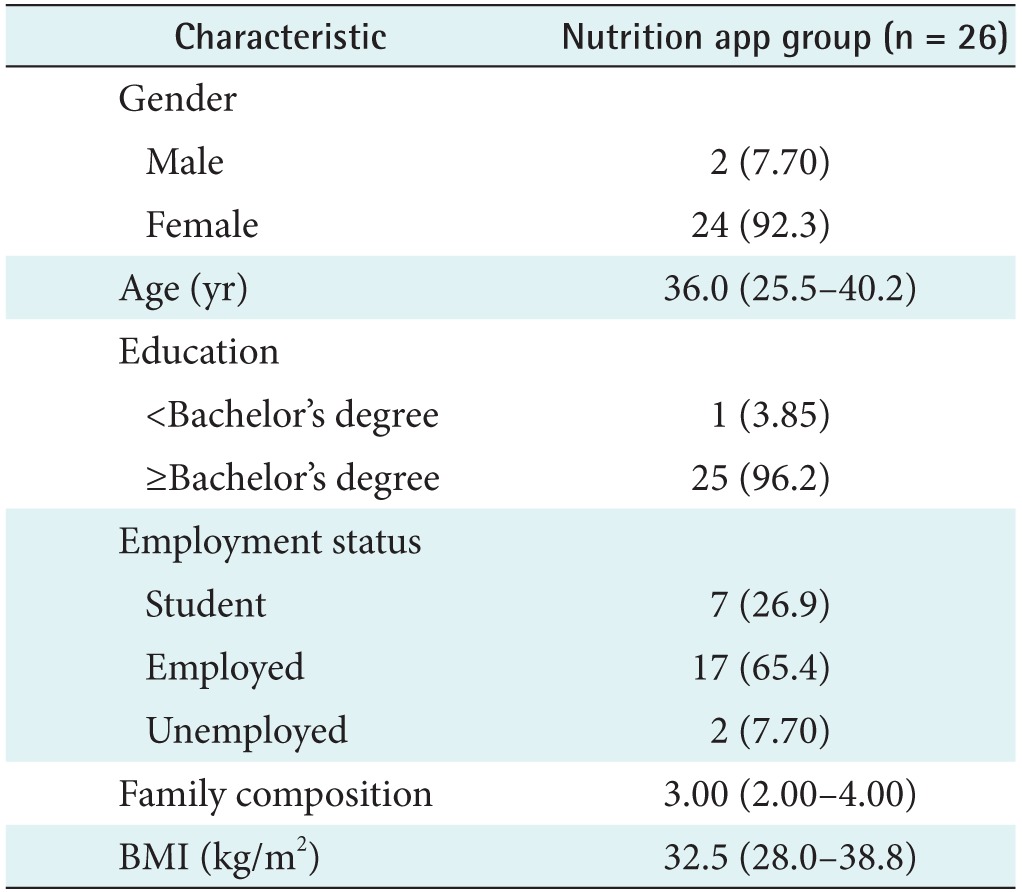
Values are presented as number of participants (%) or median (interquartile range).
BMI: body mass index.
Table 2 shows the individual items used to evaluate feasibility, usability, satisfaction, and acceptability of the app. In summary, most considered that the app was feasible (69.2%), usable at least once in the last month (88.5%), satisfactory (62.9%), and acceptable (88.5%). The percentage of participants who considered the app feasible, usable, satisfactory, and acceptable was significantly greater than 50% (p < 0.05) (Table 3).
Table 2. Feasibility, usability, satisfaction, and acceptability of the nutrition app (n = 26).
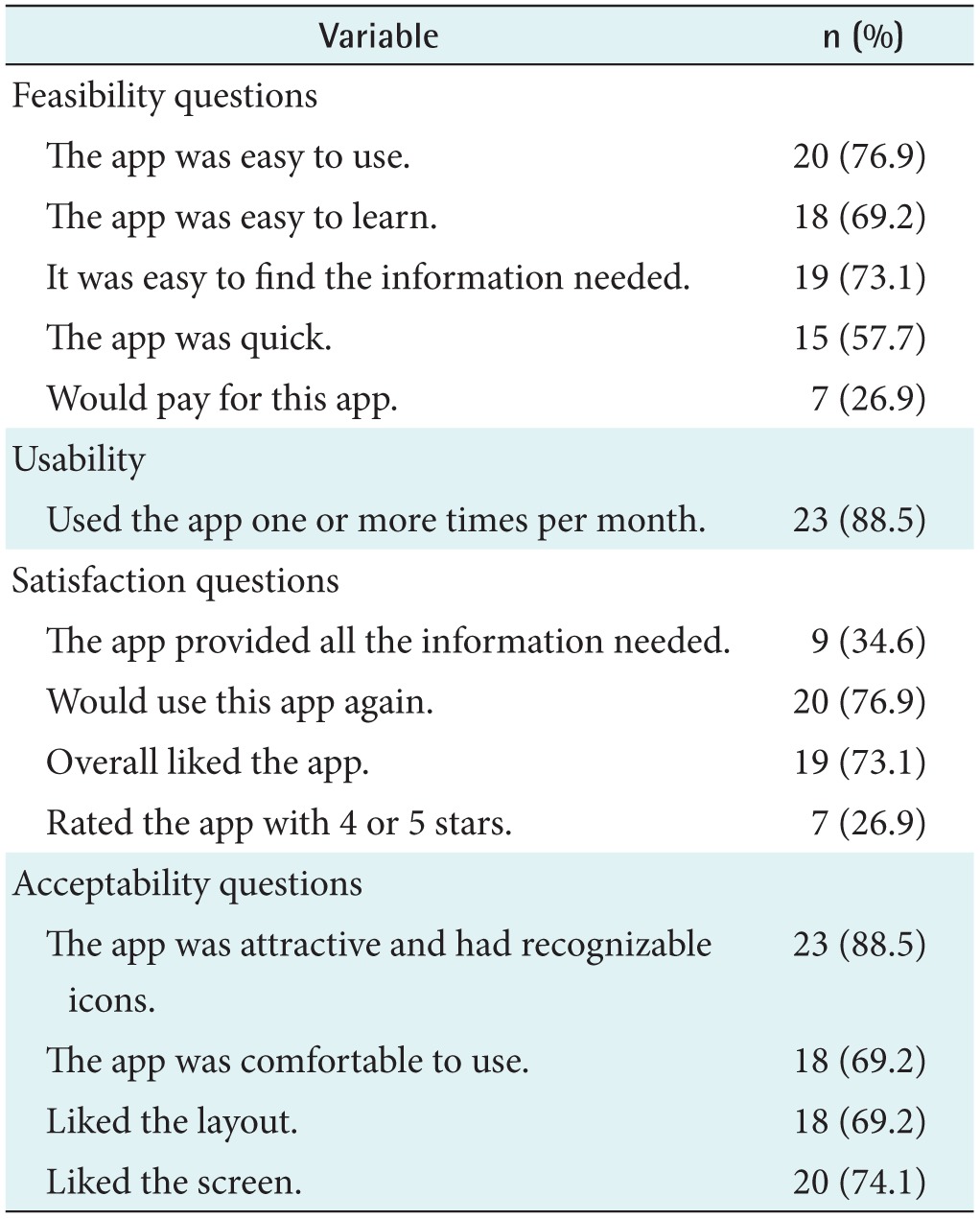
Table 3. Evaluation of the feasibility, usability, satisfaction, and acceptability hypotheses among participants (n = 26).

To test each hypothesis, a binomial test was performed.
Table 4 shows the aspects that participants liked the most about the app, such as taking into consideration the budget and food specials (14.3%), using multiple supermarkets, and providing food portions. The aspects least liked were poor food variety (26.3%) and problems with app functionality (21.0%).
Table 4. Aspects liked the most and the least by study participants (n = 26).
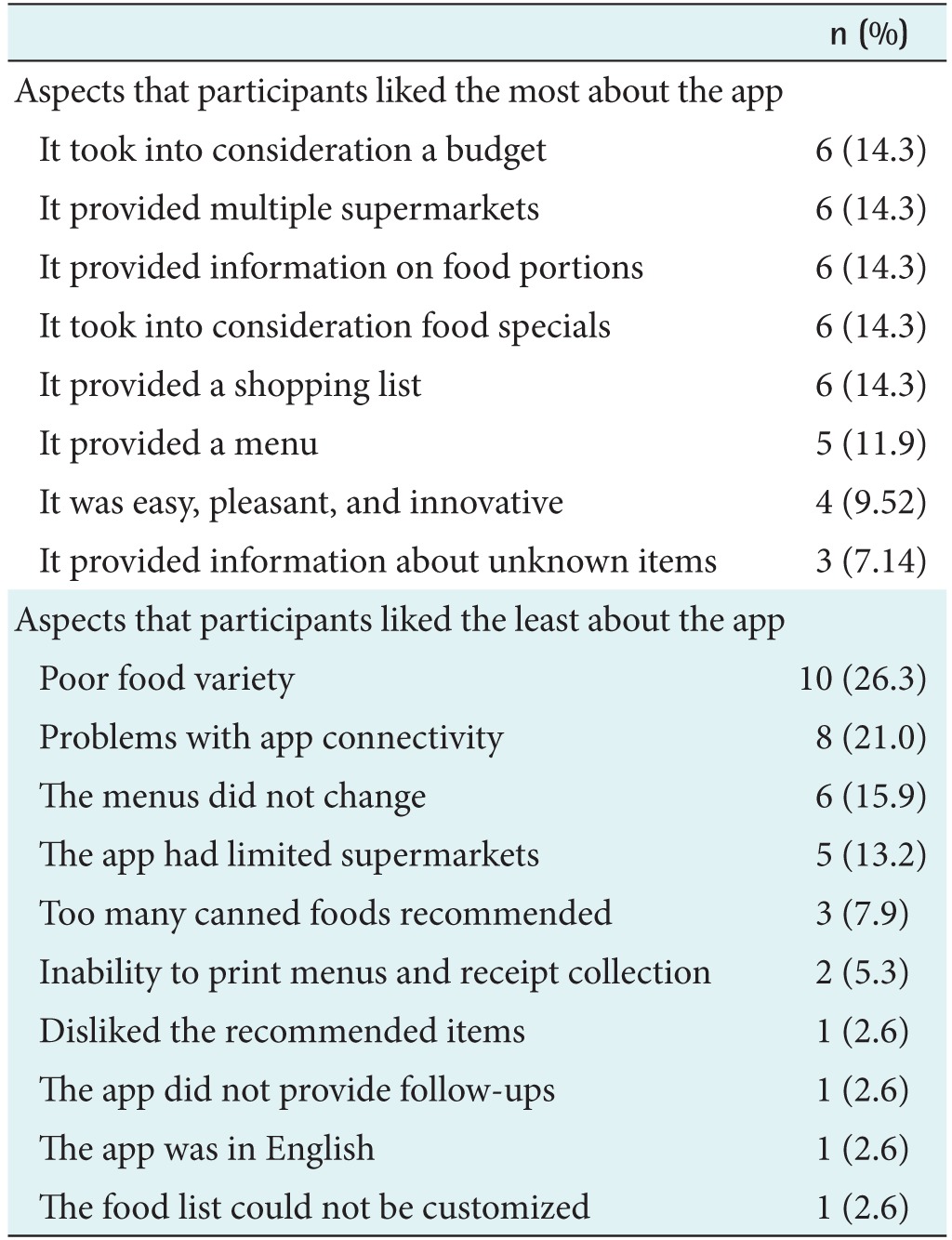
Table 5 shows the results of the short survey answered by participants at the end of each grocery shopping trip (n = 23). The average use of the app was 75% on each purchase. Only 37% of the recommended products were purchased. The food group least purchased from the recommended list was vegetables, and the most purchased was fruits. The main reasons for not purchasing the recommended items were that the participants did not like them (28.5%), the item was unavailable in the supermarket (24.3%), or the participants encountered problems using the app (16.4%).
Table 5. Short survey completed by study participants at the end of each shopping event (n = 23).

This survey was completed directly on the application at the end of each shopping event. Three participants did not complete this short survey.
IV. Discussion
“MyNutriCart” was designed for making smart and healthy choices when grocery-shopping taking into account nutritional needs, a budget, and the Dietary Guidelines for Americans. This is an important step in translating the recommendations at a key moment when individuals are faced with multiple food options and information that could confuse them. To the best of our knowledge, this is the first app to have such features. By taking into consideration the individual or family's budget, the app helps to incorporate foods that are usually perceived as expensive and often fall short in the diet (i.e., fruits and vegetables) [15,16,17].
In developing the app, the most challenging step was combining the algorithm created for generating the grocery-shopping list with the weekly discounts offered by local supermarkets. For example, the supermarket discounts included non-healthy foods as well as other items, such as cleaning supplies and miscellaneous items. We used keywords to eliminate these items from the final grocery list. In addition, although the grocery list recommended a variety of proteins (poultry, red and cured meats, and seafood), grains, vegetables, fruits, and dairy products, the supermarket weekly discounts included non-healthy versions of these foods that had to be removed from the final grocery list, such as breaded or fried proteins, high-fat cured meats (i.e., bacon), fried potatoes or sweet potatoes, fruit drinks, high-sugar ready-to-eat breakfast cereals, and regular dairy products, among others. Several iterations and tests had to be done to make sure that only healthy food options were included in the final grocery list, limiting somewhat the variability of the recommended shopping list. However, some healthy foods (e.g., brown rice) were included in the shopping list independently of them being offered in the weekly supermarket shoppers. This was done to ensure that some staple foods be included (e.g., rice). For vegetables and fruits, the shopping list was mainly created by the shoppers because these are the foods most perceived as expensive.
When evaluating the app, we found that it was feasible, usable, satisfactory, and acceptable by more than 50% of participants. Among the items most highlighted by participants was the attractiveness of the app, recognizability of the icons, and easiness to use and to find the information needed. This was an important aspect when this app was being developed. The incorporation of pictures in the shopping list made it easy to identify food products in the grocery store. Also, participants reported in the open-ended questions that the aspects they liked the most about the app were that it took into consideration a budget, it included multiple supermarkets, it took into consideration food specials, and it provided a shopping list. These answers were expected, as these are unique features of this app. The fact that participants had the opportunity to buy healthy foods, including fruits and vegetables, within their budget was one of the most important targets of this app. As previously mentioned, intake of fruits and vegetables are the main food groups that often fall short in the diets of Americans and Puerto Ricans [15,16,17]. Limited budget is the main barrier often reported for purchasing healthy foods, particularly fruits and vegetables [18]. Another barrier is lack of self-efficacy in choosing healthy foods [19]. Therefore, this app can help overcome these barriers.
In terms of usability, 75% used the app in every grocery-shopping event, but on average, only 37% of the products in the recommended shopping list were bought. This was mainly because participants or family members did not like the recommended items (28.5%) and that the item was unavailable (24.3%). Studies have shown that individual and family preferences are also important barriers for purchasing healthy foods as well as conflicting needs to satisfy oneself and others [19,20]. In addition, some items are often perceived as being more important than others to purchase, such as meats in general [20]. Therefore, other strategies or features are needed to complement the use of the App to help individuals purchase and consume healthy foods, such as using blogs or follow-ups messages with nutritionists.
In terms of satisfaction, most were satisfied with the app. However, there were some problems with connectivity, as participants reported that the app was somewhat slow when updating the weekly supermarkets' food specials and when uploading the grocery receipt at the end of the purchase. Also, some participants perceived that the grocery list had poor food variety, and this could be related to the fact that many unhealthy foods were removed from the shopping list and from the supermarkets weekly discount, limiting somewhat the variability of the recommended shopping list. This was expected as only healthy foods were recommended.
Until now, there have been very few studies investigating the feasibility, usability, satisfaction, and acceptability of nutritional mobile apps. A pilot study assessing the feasibility of available nutritional apps among low income women found that 61% (n = 11) used most apps at least weekly, 74% (n = 14) would use their preferred apps again, and most generally felt confident using the apps [21]. In an intervention trial among 128 overweight participants, those assigned to the nutritional app reported significantly higher usage, satisfaction, and convenience than those using paper or the website group (p < 0.05) [22]. Another trial among 30 overweight Spanish adolescents evaluated a nutritional App for two weeks and found that most participants considered the app easier to transport (70%) and more ‘fun’ (53.3%) compared to those assigned to the paper and pencil group [23]. However, the paper and pencil group reported that it was quicker (43.3%) and easier to use (46.7%) compared to the app group (36.7% and 16.7%, respectively), probably related to the use of a stylus pen for the app, which was difficult, uncomfortable, and slow to use [24]. Therefore, nutritional apps appeared to be considered as feasible, usable, satisfactory, and acceptable tools, but further improvements are needed.
In conclusion, “MyNutriCart” is the first available app to help individuals and families make smart and healthy choices when purchasing food in grocery stores based on their nutritional needs and on their budget. The app was rated as feasible, usable, satisfactory, and acceptable by more than 50% of participants when tested in a trial among overweight adults in Puerto Rico. Some additional aspects to be taken into consideration for improving the app include improving the variability of foods included in the shopping list, additional menu options, and expanding the supermarkets list. In the future, “MyNutriCart” could be used as a tool to translate the recommendations of the Dietary Guidelines for Americans into a practical grocery list to meet the needs of a family within a budget.
Acknowledgments
The authors would like to thank all the participants of the study and the students in the Nutrition Program, School of Public Health of the University of Puerto Rico, Medical Sciences Campus, for pre-testing the app and providing feedback. This research was performed to confer the Master Degree to the student Desiree Lopez by the University of Puerto Rico, Medical Science Campus.
Footnotes
Conflict of Interest: No potential conflict of interest relevant to this article was reported.
References
- 1.National Agricultural Library. DRI nutrient reports [Internet] Beltsville (MD): National Agricultural Library; c2016. [cited at 2017 Jan 3]. Available from: https://www.nal.usda.gov/fnic/dri-nutrient-reports. [Google Scholar]
- 2.Mozaffarian D, Appel LJ, Van Horn L. Components of a cardioprotective diet: new insights. Circulation. 2011;123(24):2870–2891. doi: 10.1161/CIRCULATIONAHA.110.968735. [DOI] [PMC free article] [PubMed] [Google Scholar]
- 3.Guilbert JJ. The world health report 2002: reducing risks, promoting healthy life. Educ Health (Abingdon) 2003;16(2):230. doi: 10.1080/1357628031000116808. [DOI] [PubMed] [Google Scholar]
- 4.Centers for Disease Control and Prevention. BRFSS prevalence & trends data: explore by location [Internet] Atlanta (GA): Centers for Disease Control and Prevention; c2017. [cited at 2017 Jan 3]. Available from: http://www.cdc.gov/brfss/brfssprevalence/ [Google Scholar]
- 5.Mayo Clinic. Risk factors of obesity [Internet] Scottsdale (AZ): Mayo Clinic; 2015. [cited at 2017 Jan 3]. Available from: http://www.mayoclinic.org/diseasesconditions/obesity/basics/risk-factors/con-20014834. [Google Scholar]
- 6.US Department of Agriculture. Dietary Guidelines for Americans 2015-2020 [Internet] Washington (DC): US Department of Agriculture; 2015. [cited at 2017 Jan 3]. Available from: http://health.gov/dietaryguidelines/2015/guidelines/executive-summary/ [Google Scholar]
- 7.Office of Disease Prevention and Health Promotion. Eat healthy, be active community workshops [Internet] Rockville (MD): Office of Disease Prevention and Health Promotion; 2012. [cited at 2017 Jan 3]. Available from: http://www.health.gov/dietaryguidelines/workshops/DGA_Workshops_Complete.pdf. [Google Scholar]
- 8.Guenther PM, Kirkpatrick SI, Reedy J, Krebs-Smith SM, Buckman DW, Dodd KW, et al. The Healthy Eating Index-2010 is a valid and reliable measure of diet quality according to the 2010 Dietary Guidelines for Americans. J Nutr. 2014;144(3):399–407. doi: 10.3945/jn.113.183079. [DOI] [PMC free article] [PubMed] [Google Scholar]
- 9.Fitriana N, Madanijah S, Ekayanti I. Analysis of media use in the nutrition education on knowledge, attitude and practice of the breakfast habits on elementary school students. Pak J Nutr. 2015;14(6):335–345. [Google Scholar]
- 10.Bello Lujan LM, Armas Navarro A, Jimenez Suarez M, Hernandez Betencourt L, Serra Majem L. Nontraditional nutrition education interventions: the radio ECCA method. Eur J Clin Nutr. 2003;57(Suppl 1):S86–S89. doi: 10.1038/sj.ejcn.1601811. [DOI] [PubMed] [Google Scholar]
- 11.Lieffers JR, Vance VA, Hanning RM. Use of mobile device applications in Canadian dietetic practice. Can J Diet Pract Res. 2014;75(1):41–47. doi: 10.3148/75.1.2014.41. [DOI] [PubMed] [Google Scholar]
- 12.McGriff SJ. Instructional System Design (ISD): using the ADDIE model [Internet] State College (PA): College of Education, Penn State University; 2000. [cited at 2017 Jan 3]. Available from: https://www.lib.purdue.edu/sites/default/files/directory/butler38/ADDIE.pdf. [Google Scholar]
- 13.US Department of Agriculture. Dietary Guidelines for Americans 2010 [Internet] Washington (DC): US Department of Agriculture; 2010. [cited 2017 Jan 3]. Available from: http://health.gov/dietaryguidelines/dga2010/dietaryguidelines2010.pdf. [Google Scholar]
- 14.Academy of Nutrition and Dietetics. Adult Weight Managemetn (AWM) guideline: major recommendations (2014) [Internet] Chicago (IL): Academy of Nutrition and Dietetics; 2015. [cited at 2017 Jan 3]. Available from: http://www.andeal.org/vault/pq132.pdf. [Google Scholar]
- 15.Colon-Lopez V, Banerjee G, Gertz AM, Ortiz AP, Calo W, Finney-Rutten LJ, et al. Behavioral correlates of fruit and vegetable intake in Puerto Rico: results from the Health Information National Trends Survey. P R Health Sci J. 2013;32(4):194–199. [PMC free article] [PubMed] [Google Scholar]
- 16.Kimmons J, Gillespie C, Seymour J, Serdula M, Blanck HM. Fruit and vegetable intake among adolescents and adults in the United States: percentage meeting individualized recommendations. Medscape J Med. 2009;11(1):26. [PMC free article] [PubMed] [Google Scholar]
- 17.Torres R, Santos E, Orraca L, Elias A, Palacios C. Diet quality, social determinants, and weight status in Puerto Rican children aged 12 years. J Acad Nutr Diet. 2014;114(8):1230–1235. doi: 10.1016/j.jand.2014.01.011. [DOI] [PMC free article] [PubMed] [Google Scholar]
- 18.Krolner R, Rasmussen M, Brug J, Klepp KI, Wind M, Due P. Determinants of fruit and vegetable consumption among children and adolescents: a review of the literature. Part II: qualitative studies. Int J Behav Nutr Phys Act. 2011;8:112. doi: 10.1186/1479-5868-8-112. [DOI] [PMC free article] [PubMed] [Google Scholar]
- 19.Hollywood LE, Cuskelly GJ, O'Brien M, McConnon A, Barnett J, Raats MM, et al. Healthful grocery shopping: perceptions and barriers. Appetite. 2013;70:119–126. doi: 10.1016/j.appet.2013.06.090. [DOI] [PubMed] [Google Scholar]
- 20.Wiig K, Smith C. The art of grocery shopping on a food stamp budget: factors influencing the food choices of low-income women as they try to make ends meet. Public Health Nutr. 2009;12(10):1726–1734. doi: 10.1017/S1368980008004102. [DOI] [PubMed] [Google Scholar]
- 21.Ball K, Mouchacca J, Jackson M. The feasibility and appeal of mobile ‘apps’ for supporting healthy food purchasing and consumption among socioeconomically disadvantaged women: a pilot study. Health Promot J Austr. 2014;25(2):79–82. doi: 10.1071/HE13096. [DOI] [PubMed] [Google Scholar]
- 22.Carter MC, Burley VJ, Nykjaer C, Cade JE. Adherence to a smartphone application for weight loss compared to website and paper diary: pilot randomized controlled trial. J Med Internet Res. 2013;15(4):e32. doi: 10.2196/jmir.2283. [DOI] [PMC free article] [PubMed] [Google Scholar]
- 23.Oliver E, Banos RM, Cebolla A, Lurbe E, Alvarez-Pitti J, Botella C. An electronic system (PDA) to record dietary and physical activity in obese adolescents: data about efficiency and feasibility. Nutr Hosp. 2013;28(6):1860–1866. [PubMed] [Google Scholar]




